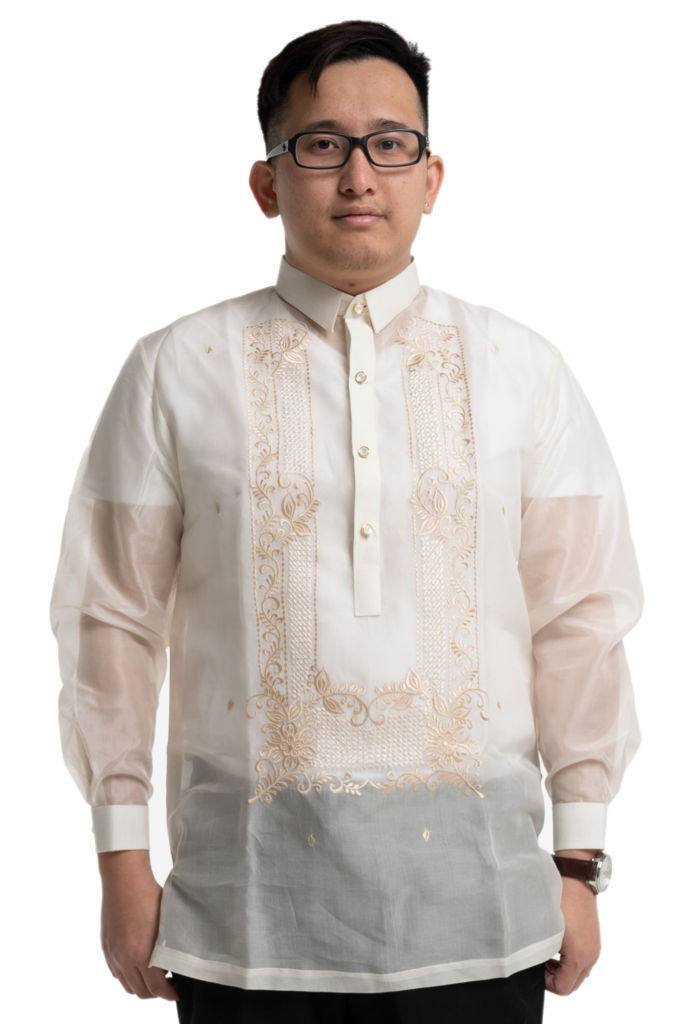Indicators on Barong Tagalog Store You Need To Know
Table of ContentsThe Ultimate Guide To Barong Tagalog StoreRumored Buzz on Barong Tagalog Jacket3 Easy Facts About Formal Barong Tagalog Shown

It is an usual formal or semi-formal outfit in Filipino society, as well as is worn untucked over an underwear with belted pants as well as outfit footwear. Baro't saya is the womanly equivalent of barong tagalog, with the Maria Clara dress being the formal variation of the latter. Barong tagalog was additionally known as ("outer shirt") in Philippine Spanish. formal barong tagalog. The term is generally not taken advantage of.
Rather, the name was coined to distinguish the outfit as native (thus "tagalog", i. e. ), in contrast to the styles of gown of Europeans as well as other international cultures. Description [edit] Barong tagalog used with a salakot. The lady is putting on a. Barong tagalog is a formal shirt typically made of large light-weight but rigid material called (generally woven from pia or abac fibers).
Barong tagalog can vary significantly in regards to design and product made use of, however they share common attributes of having long sleeves, needlework, being buttoned (halfway or directly down the breast), and also the lack of pockets. They are also put on loosely and also have slits on both sides. Historically, the product utilized for barong tagalog depended on the social course of the user as well as the formality of the occasion.
Get This Report about Where To Buy Barong Tagalog

The high quality of the material and also the details of the needlework were typically indicators of the status and wide range of the wearer. The needlework of the barong tagalog are frequently placed on a rectangular section on the front of the breast (called pechera, "shirt front", from Spanish pecho, "breast"), and/or over the whole t-shirt (sabog, from Tagalog for "spread"). Clicking Here.
History [modify] Pre-colonial age [modify] The barong tagalog originated from the Tagalog baro (actually "t-shirt" or "clothes", additionally called bar or bay in various other Philippine languages), a basic collar-less t shirt or jacket with close-fitting lengthy sleeves worn by both males and also ladies in the majority of ethnic groups in the pre-colonial Philippines. These were made from harsh linen-like towel woven from indigenous abac fiber, or from imported fabrics woven from silk, cotton, as well as kapok, to name a few. Amongst Tagalog males, they were commonly coupled with a rectangular shape of richly enhanced cloth known as the salaual or salawal worn knee-length as well as created in the center (like an Indian or Thai and Cambodian ); while in ladies they were coupled with a wraparound skirt referred to as the.
, apart from similar baro (which had much shorter sleeves) as well as salaual combinations, useful link males also used colorful robe-like and coat-like versions that could prolong to well below the knees (known as the marlota as well as baquero in Spanish, respectively). These were often belted at the waist.

Barong Tagalog Things To Know Before You Get This
The couturier Jose "Pitoy" Moreno has hypothesized that this transitional design of shirt was the camisa de chino of later centuries, which makes it a precursor to the barong tagalog. Representations of participants of the upper classes (including citizens and also) in the 18th century revealed that they usually used European-style clothes. go to the website.
These were a lot longer than the modern barong tagalog, getting to to somewhat above the knees. They were also generally candy striped with vibrant colors like blue, red, or environment-friendly. Nonetheless, they already showed characteristics of the contemporary barong tagalog, including being constructed from large nipis product, needlework, lengthy sleeves, and a loose silhouette with slits on both sides - read review.
The sheer material made use of by barong mahaba likewise demanded the wearing of an underwear, called camisn or camiseta, which was additionally endured its very own by citizens. By the 1840s, barong mahaba mostly befalled of fashion. In this duration, it progressed into the modern "classic" barong tagalog, being much shorter with much less extravagant folded up collars, while still maintaining the large textile and various other baro features.